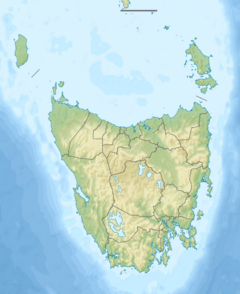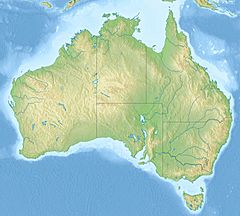Kutikina Cave facts for kids
| Alternative name | Fraser Cave |
|---|---|
| Location | South West Wilderness |
| Region | Tasmania, Australia |
| Coordinates | 42°31′42″S 145°46′8.4″E / 42.52833°S 145.769000°E |
| Site notes | |
| Excavation dates | 1980s |
| Archaeologists | Don Ranson and Rhys Jones |
Kutikina Cave, also known as Kuti Kina or Fraser Cave, is a special rock shelter found along the Franklin River. It is located in the South West Wilderness, a protected World Heritage Area in Tasmania, Australia. This cave is very important because it shows us how long Aboriginal people have lived in Tasmania, going back to the Pleistocene Ice Age.
Contents
Discovering Ancient Life in Kutikina Cave
Kutikina Cave was first found in 1977 by Kevin Kiernan, a student studying how the Earth's surface changes (geomorphology). Later, in the 1980s, a team of archaeologists led by Don Ranson and Rhys Jones began to explore it.
What Archaeologists Found
The main excavations happened in 1981. Inside the cave, archaeologists discovered amazing clues about human life during the Pleistocene period, also known as the Ice Age. This was a time when the world was much colder.
Evidence of Ice Age Hunters
The findings showed that people lived in Kutikina Cave when the land around it was a cold, open tundra. They hunted wallabies, especially the Bennets Wallaby. The cave had more than 250,000 bone pieces and 75,000 stone tools! This made it one of the richest archaeological sites ever found in Tasmania and Australia.
Most of the bones were from wallaby legs. People would split these bones to get out the nutritious marrow. At the time, Kutikina Cave was the most southerly place in the world where humans lived during the last major ice age.
Kutikina Cave and the Franklin Dam Debate
Kutikina Cave played a big part in a famous environmental argument called the Franklin Dam controversy. The cave was first named "Fraser Cave" by Kevin Kiernan. He named it after the Prime Minister at the time, Malcolm Fraser.
Protecting the Wilderness
Kiernan wanted to draw attention to the importance of the Tasmanian wilderness and the Franklin River. These areas were in danger because the Tasmanian Hydro-Electric Commission wanted to build a dam there. The discovery of Kutikina Cave and its ancient human history helped show how valuable and unique this area was, leading to strong protests and eventually protecting the river and the cave.



